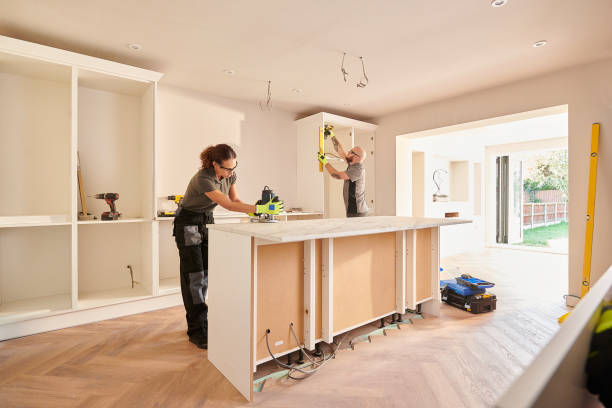Homeowners today want comfort, style, and efficiency, but not every home renovation adds value when it comes time to sell. Some upgrades pay for themselves many times over, while others drain money without improving the resale value. In the Kingston and Frontenac market, where older homes mix with new subdivisions and rural acreages, knowing which projects deliver ROI can make all the difference.
This guide highlights the home renovations that matter most to buyers in our area, the ones that tend to fall short, and how to time your projects for the best return. For instance, a well-executed kitchen renovation can potentially increase the value of your home by 10–15%, while a bathroom remodel can yield a return of 60–70% on your investment.
1. Bathroom Renovations: Spa Comfort Meets Smart ROI
Bathrooms have always been one of the most popular home renovations, and they remain one of the top areas buyers evaluate closely. Whether it is a powder room, a family bath, or a master ensuite, buyers want spaces that feel clean, functional, and ideally luxurious.
For smaller rooms, light colours, mirrors, and a “less is more” approach can visually enlarge the space. Large wallpaper prints or bold stripes can overwhelm a tight room, while smaller patterns or soft paint shades help it feel bigger. Even extending a countertop over the back of a toilet, known as a “banjo counter,” is a clever way to gain extra surface space without sacrificing function.
Storage matters. Pedestal sinks open up floor space, but they sacrifice storage, so wall-mounted cabinets above toilets or vanities are often a better solution. Open shelving is another option that appears less bulky and avoids the clearance issues associated with cupboard doors. Rounded shower bases in corners, shallow-depth cabinets, and folding doors all help maximize the space in narrow bathrooms.
Luxury features that buyers may expect today include heated floors, double vanities, smart showers with digital temperature controls, and water-saving fixtures. These are especially attractive in homes with septic systems, since they reduce strain on tanks.
What to avoid or replace: Jet tubs were once considered the height of luxury, but they are noisy, hard to clean, and rarely used. Today, they make bathrooms feel dated and bulky. Buyers prefer a sleek walk-in shower or a freestanding soaker tub. If you have the space for both, that combination remains the gold standard. Standalone bidets are another relic; modern bidet seats that fit standard toilets are more practical, especially in rural homes. Poor ventilation is also a deal-breaker. Many older homes were built without bathroom fans, which leads to moisture, mildew, and mould. A modern fan/light combination is an inexpensive upgrade that protects your investment.
Basement bathrooms and laundry connections: Adding a basement bathroom can be a smart move, but because the plumbing sits below the sewer line, an ejector pump is essential. These pumps can often be tied into basement laundry systems, which is practical and efficient. Laundry rooms themselves have become a strong selling feature. Moving laundry above ground into a bright, dedicated space is one of the most underrated ROI boosters in today’s market. A laundry remodel typically recoups 40 to 70 percent of its cost.
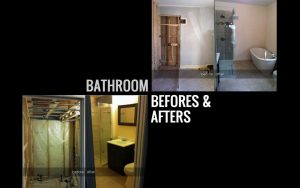
Costs and ROI in 2025: A complete bathroom renovation, which includes updating all fixtures, tiles, and possibly reconfiguring the layout, typically costs between $12,000 and $25,000 CAD. A master ensuite remodel, which may involve adding luxury features like a double vanity or a smart shower, can range from $20,000 to $40,000 CAD. These reflect the average costs in Ontario for 2025. Homeowners should expect both material and labour prices to rise in the coming years, which makes careful planning even more critical.
___________________________________________________________________________________________________
2. Kitchen Renovations: The Heart of Every Home
Kitchens are one of the most powerful home renovations for influencing buyers. A well-designed kitchen isn’t just about cooking — it’s about daily life, entertaining, and creating a central hub for the household.
Not all kitchen renovations deliver the same return. I’ve seen homeowners invest $60,000 in a dream kitchen for a $550,000 home, only to recoup half that amount at resale. At the same time, I’ve seen $15,000 refreshes with painted cabinets, updated lighting, and new appliances spark bidding wars. The difference is strategy.
Appliances buyers notice: Gas ovens remain the choice for serious cooks, while electric ovens are standard in most homes, and induction is gaining traction. Convection ovens are expected, while air fryers have become the practical alternative when space or budget is limited. Over-the-range microwaves are losing ground, replaced by microwave drawers or standalone units paired with proper hood fans. Ventilation is no longer an afterthought — a quiet, stylish hood that vents outside is now a sought-after feature.
Design features that sell: Multi-functional islands, smart pantry storage, sustainable finishes, and layered lighting.
Minor upgrades with significant impact: Cabinet painting, new hardware, updated lighting, refinished floors, and a bold feature like a backsplash can mimic the feel of a remodel at a fraction of the cost.
Costs and ROI in 2025: Minor refresh: $8,000–15,000 CAD; mid-range renovation: $25,000–45,000 CAD; high-end remodel: $50,000–80,000+ CAD. Canadian averages show kitchen remodels can return 90–96 percent of their costs when matched to the home’s market value. These figures reflect 2025 pricing, and costs are trending upward annually.
3. Window and Door Renovations for Comfort and Curb Appeal
Windows and doors may not feel as glamorous as kitchens or baths, but they are critical home renovations in our climate. They influence comfort, heating bills, and curb appeal.
Quick fixes include weatherstripping and caulking to seal leaks, adding storm windows for an extra barrier, or even applying heavy-gauge clear plastic for temporary winter protection.
When to replace: Complete replacement can be phased in. Start with the worst offenders — often large picture windows or sliding patio doors.
What buyers expect today: Buyers are increasingly looking for triple-pane windows with hybrid frames, which combine the strength of wood with the low maintenance of vinyl. They also prefer Low-E coatings with argon gas, which provide better insulation by reflecting heat back into the room. For doors, insulated entry doors and patio doors that improve indoor-outdoor flow are in high demand.
Sidebar: Personal Experience
In my own home, a 100+ year old stone foundation was a constant source of dampness until I added spray foam insulation. The difference was immediate — the basement became warmer, drier, and far less costly to heat. Buyers of heritage homes value these kinds of upgrades.
Costs and ROI in 2025: Basement window replacements: $300–600 CAD installed; egress windows: $1,000–3,000 CAD; above-grade window replacements: $800–2,500 CAD; insulated entry doors: $2,000–5,000 CAD. Energy-efficient windows typically return 65–75 percent of their cost, and door replacements often return even more..
4. Curb Appeal: First Impressions That Sell Homes
Before buyers step inside, they’ve already judged your home. A tidy exterior suggests pride of ownership, while a neglected one leaves buyers wondering what else might be wrong inside.
Fresh landscaping is often the starting point. Native plants, trimmed shrubs, and a clean lawn can transform a property in just a weekend. Even stone borders or a pair of shrubs near the entry can make a modest home feel polished.
Garage doors are another overlooked upgrade. A dented or dated door can drag down the entire exterior, while a new, insulated model instantly improves the look. Exterior lighting plays the same role, enhancing safety while setting the tone for evening showings. Well-placed fixtures highlight the home’s best features, while motion-sensor lights, doorbell cameras, and visible security systems add another layer of appeal by blending convenience with peace of mind.
Driveways and walkways deserve attention. In our climate, freeze-thaw cycles are tough on asphalt and concrete. A sealed driveway, patched cracks, and swept paths make a difference.
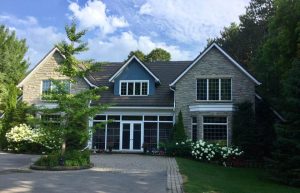
Faded siding or peeling trim can quietly pull down value. New siding or a fresh coat of paint can add years to a home’s life. On the higher end, stone veneer looks beautiful but comes at a steep price. For sellers moving soon, it rarely returns its cost. Unless you plan to stay and enjoy it for years, focus on lower-cost upgrades.
Sidebar: A Local Success Story
I heard about one seller who invested about $4,500 in landscaping and exterior paint. The home sold in its first weekend, receiving three offers, all above the asking price. Sometimes the smallest investments deliver the most significant rewards.
Costs and ROI in 2025: Landscaping refresh: $750–2,500 CAD; professional overhaul: $3,000–12,000 CAD; garage door: $1,800–6,000 CAD; driveway sealing: $500–2,500 CAD; siding replacement: $12,000–25,000 CAD+; stone veneer: $20,000–40,000 CAD. These are 2025 averages, and costs are expected to continue rising.
5. Deck Renovations and Outdoor Living Spaces Buyers Love
A great deck is one of the most versatile home renovations a seller can undertake, and it remains among the strongest outdoor projects for return on investment. Buyers do not just see boards and railings; they imagine family dinners, quiet mornings with coffee, summer barbecues, and a natural flow between indoor and outdoor living. In Kingston and Frontenac, where summers are treasured and rural acreages often have views and wind exposure, a well-planned deck becomes an extension of the home rather than an afterthought.
Start with proportion and layout. A deck that fits the scale of the house and lot always shows better than one that overwhelms the façade or pinches walkways. Think in zones. One area can handle a dining table, another a lounge set, and a third a grill station. Keep clear paths between the door and seating so no one has to squeeze past chairs with a tray in hand. If the kitchen is far from the exterior door, consider a narrow landing or bump-out to make serving easier. Place stairs where they are useful, not where they cut the deck in half.
Structure matters in our climate. Footings should extend below the frost line, and flashing at the ledger must be watertight to protect the house. Helical piles are becoming popular because they disturb less soil and handle frost heave well. Joist spacing needs to match the surface material; many composite and PVC boards require tighter spacing than wood. If you want to create a dry sitting area under an elevated deck, ask about under-deck drainage systems that divert water to a gutter and downspout, turning the space below into bonus living area.
Choose materials with your maintenance tolerance in mind. Pressure-treated lumber remains the budget-friendly standard and, when detailed correctly, looks clean and solid. Cedar is naturally rot resistant and warms up beautifully with semi-transparent stain. Composite and PVC boards cost more up front yet save time over the years because they do not need regular staining. Hidden fastener systems create a neat surface and prevent snags. For railings, aluminum stands up to weather and salt air near the water, glass panels preserve views, and wood suits heritage and farmhouse styles. Privacy screens can tame wind on rural lots and create a defined seating nook without closing the space in.
Comfort features bring the deck to life. Low-voltage lights on stair risers, post caps, or under rails make evening use feel welcoming and safe. If you plan to run a gas line for a barbecue or fire table, use a licensed contractor and include a shut-off that is easy to reach. Exterior receptacles with GFCI protection simplify heaters, speakers, or holiday lights. Shade can be as simple as a market umbrella or as permanent as a pergola or awning. Skirting should be vented to avoid moisture build-up and designed to keep critters out, especially on rural acreages.
Permits and by-laws are not optional. Most municipalities require a permit when a deck is attached to the house, exceeds a certain height, or includes a roofed structure. Property line setbacks, guard heights, and stair dimensions must meet the Ontario Building Code. Always arrange utility locates before digging. A permitted, code-compliant deck reassures buyers that the work was done properly and helps you avoid last-minute surprises during a sale.
Outdoor kitchens deserve a careful second look. They photograph beautifully and can be a joy for frequent entertainers, yet our outdoor season is relatively short. Many owners use only the grill while the fridge, sink, and built-in cabinets see little action and demand winterization. If you love the idea and plan to stay, choose outdoor-rated appliances, design for easy draining and shut-offs, and use durable materials that handle freeze-thaw cycles. If you are selling soon, a polished deck with comfortable seating, soft lighting, and perhaps a CSA-approved gas or propane fire table will appeal to more buyers for less money than a full kitchen island.
Maintenance expectations should be clear. Wood needs a cleaning and fresh stain every two or three seasons, depending on sun and snow exposure. Composite needs a spring wash and general care but no staining. Buyers appreciate honest notes about upkeep, and they respond to decks that look clean, dry, and solid underfoot. A few planters, neutral cushions, and a tidy storage bench go a long way in showings.
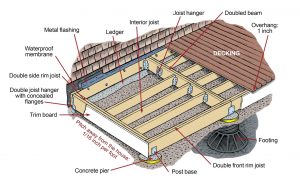
Costs and ROI in 2025: Basic wood deck: $8,000–15,000 CAD; composite deck: $15,000–30,000 CAD; outdoor kitchen: $20,000–50,000+ CAD. Decks often return 70–80% of their cost at resale, while outdoor kitchens typically return less than 50%.
Costs and ROI in 2025 (Ontario averages, continuing to rise)
-
Basic wood deck, installed: $8,000–15,000 CAD
-
Composite or PVC deck, installed: $15,000–30,000 CAD
-
Railing, installed (aluminum, glass, or wood): $65–150 per linear foot
-
Privacy screen or wind panel: $700–2,500 CAD
-
Pergola or shade structure: $3,000–10,000 CAD
-
Under-deck drainage system: $20–40 per sq. ft.
-
Low-voltage lighting package: $600–2,000 CAD
-
Gas line to grill or fire table: $600–1,500 CAD
-
Electrical additions (GFCI outlets, lighting circuits): $500–1,500 CAD
-
Permit and inspections: $200–1,000 CAD
-
Outdoor kitchen, modular: $8,000–20,000 CAD
-
Outdoor kitchen, built-in: $20,000–50,000+ CAD
6. Energy Efficiency: Comfort, Savings, and Value in Kingston & Area
Energy efficiency has quickly become one of the top priorities for buyers in Kingston and Frontenac. With Hydro costs on the rise and winters that seem to get longer and harsher, most buyers want a home that feels warm, dry, and economical to run.
Insulation is often the first place to start. Attic insulation with an R-value of 50 or higher is now considered the standard. In older homes with stone foundations, spray foam insulation is particularly effective — not only does it cut down on dampness, it also makes the house warmer and significantly reduces heating costs.
Windows and doors play a major role as well. Triple-pane windows with hybrid frames are quickly becoming the expectation, combining the strength of wood with the low maintenance of vinyl. Low-E coatings with argon gas help reflect heat back into the room during the winter and keep homes cooler in the summer. Even replacing the draftiest windows in an older home can have an immediate impact on comfort and monthly bills. Insulated entry doors and modern patio doors add the same value, improving both energy performance and curb appeal.
Double vs. triple pane: Double-pane windows remain common and serviceable, but triple-pane models are increasingly preferred in Ontario. They provide superior insulation and noise reduction and are often mentioned by buyers as a desirable feature
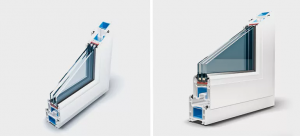
Heating and cooling choices depend on location. In the city, natural gas remains standard. In rural areas, many homes still rely on propane, oil, or hybrid systems, while acreages with plenty of trees sometimes turn to wood-burning furnaces as part of their heating plan. Heat pumps are another option that is gaining popularity. They provide both heating and cooling and offer a solid return on investment at resale.
Smaller upgrades also make a difference. Smart thermostats, LED lighting, and water-saving fixtures are inexpensive changes that buyers notice. In rural homes with septic systems, water-efficient toilets and modern bidet seats help extend the life of tanks while appealing to eco-conscious buyers.
Sidebar: A Kingston Case Study
One family upgraded their attic insulation, replaced aging windows, and installed a new gas furnace. Their annual heating bills dropped by nearly $1,000, and the documented energy audit became a strong selling feature when they listed the home.
Costs and ROI in 2025: Attic insulation: $3,000–6,000 CAD; basement windows: $300–600 CAD; egress windows: $1,000–3,000 CAD; above-grade windows: $800–2,500 CAD; entry doors: $2,000–5,000 CAD; heat pumps: $12,000–20,000 CAD; smart thermostats: $200–500 CAD. These reflect 2025 averages in Ontario, and both material and labour costs are expected to continue rising.
7. Renovations To Avoid: Money Pits That Rarely Pay Off
While many renovations can help sell a home faster and for more money, there are some projects that almost never return what you put into them. Pools and hot tubs top that list. They may create wonderful memories, but in Kingston and Frontenac the outdoor season is short and the maintenance is high. Many buyers see them as more of a liability than a luxury.
Basement renovations can also be a trap. A clean, bright basement certainly adds appeal, but going overboard with theatre rooms, built-in bars, or extravagant finishes rarely pays back at resale. The same is true of solar panels. While they do lower monthly bills in the long term, most buyers in our area don’t add their full value to an offer. Reducing bedrooms by combining or converting them is another common mistake — nothing lowers resale value faster than cutting into bedroom count.
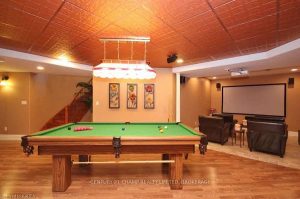
Highly customized projects often fall into the same category. A copper ceiling may be a personal dream, but it won’t appeal to the majority of buyers. The same goes for themed rooms, elaborate murals, or permanent specialty spaces that only serve a niche interest.
Sidebar: The Indoor Golf Simulator.
I recently toured a home equipped with a complete golf simulator system, featuring a launch monitor, impact screen, projector, and software for global courses. For golfers, it was incredible. For most buyers, it was just an expensive feature to remove. That’s the difference between renovating for yourself and renovations for resale.
Costs and ROI in 2025: In-ground pools: $45,000–120,000+ CAD, ROI under 50%; hot tubs: $8,000–35,000 CAD; major basement finishing: $40,000–100,000 CAD, ROI 50–60%; solar panels: $20,000–50,000 CAD; bedroom conversions: ROI negative. These figures reflect Ontario averages, and as with most projects, costs are expected to continue rising.
8. Timing Your Renovations By Ontario Seasons
When you renovate, it can be just as important as what you renovate.
Spring: Assess winter damage, repair roofs and siding, seal driveways, and refresh landscaping.
Summer: Best for major outdoor work, including roofing, siding, new windows, and deck construction.
Fall: Focus shifts indoors. Kitchens, bathrooms, insulation, and furnace service make sense.
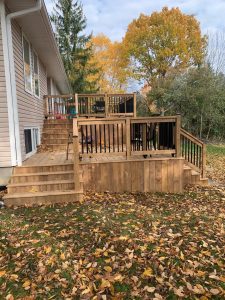
Winter: Time to plan and design. Smaller indoor projects, such as painting or flooring, also fit here. Winter prep positions your home for the spring market.
Sidebar: Why Timing Matters
On city lots, spring curb appeal work maximizes buyer impact. On rural acreages, wind and snow damage often need attention as soon as the weather allows.
Costs and ROI in 2025: Exterior work, such as landscaping and roofing, often peaks in cost during spring and summer. Interior projects may be less expensive in winter when contractors are less busy
9. Small Renovations with Big Impact
Not every home renovation requires a major budget. In fact, some of the most effective upgrades are also the simplest — quick, targeted updates that freshen a home’s look, boost its perceived value, and make buyers take notice. These projects work especially well in Kingston and Frontenac, where many buyers are looking for move-in ready homes but are also balancing tight budgets.
Start with paint. Fresh paint in modern, neutral tones like warm greys, soft beiges, or clean whites can instantly transform a space. It hides scuffs and wear, makes rooms feel larger and brighter, and creates the clean, blank canvas buyers love. Avoid bold colours unless they are used sparingly as accents — even a beautiful colour can be polarizing. A simple repaint is one of the most cost-effective ways to modernize older homes in our area without heavy renovations.
Refinish floors. Hardwood that looks worn or scratched can drag down a home’s perceived quality. Refinishing it adds warmth and character back into the space, often making it look as though the whole home has been updated. It also signals to buyers that the home has been well cared for, which adds intangible value well beyond the surface appearance. Vinyl plank or laminate flooring can also be replaced in key rooms to create a cohesive flow through the house.
Upgrade lighting. Lighting is often overlooked, yet it shapes how buyers experience every room. Old dome lights and fluorescent fixtures cast harsh or uneven light. Swapping them for LED pot lights, modern flush mounts, or stylish pendants makes spaces feel brighter, larger, and more welcoming. Layering light — combining ceiling lights with under-cabinet strips, sconces, or lamps — highlights the home’s best features and creates depth.
Refresh hardware and fixtures. Even small hardware changes can transform kitchens and bathrooms for very little cost. New cabinet handles, modern faucets, matching doorknobs, and sleek switch plates create a sense of cohesion and polish. If your budget allows, swap out dated towel bars, toilet paper holders, and shower heads at the same time for a fully refreshed look.
Add entry-level smart home features. Buyers increasingly expect convenience and efficiency. Basic smart home upgrades like programmable thermostats, video doorbells, smart locks, or smart bulbs are relatively inexpensive but add perceived value. In rural homes, a Wi-Fi-enabled thermostat or humidity sensor can also help prevent frozen pipes or dampness while the property is vacant — something buyers notice and appreciate.
These smaller projects might seem minor in isolation, but together they give a home the polished, well-maintained look that buyers are willing to pay for. In a competitive market like Kingston and Frontenac, where multiple offers are common on well-presented homes, these updates can make the difference between “just another showing” and “the one.”
Costs and ROI in 2025 (Ontario averages, rising annually):
-
Fresh interior paint (whole home): $3,000–6,000 CAD
-
Floor refinishing (hardwood): $3,000–8,000 CAD
-
Lighting upgrades: $1,000–3,000 CAD
-
Hardware and fixture replacement: $200–1,000 CAD
-
Basic smart home features: $200–1,500 CAD
Typical ROI:
These projects often return 100–150% of their cost — making them some of the highest-value renovations homeowners can do before listing.
___________________________________________________________________________________________________________________________________________________________________
10. Pre-Sale Prep: Clearing the Hidden Deal-Breakers
Even the best home renovations will not impress buyers if the rest of your home sends the wrong message. Cluttered surfaces, lingering odours, and small signs of neglect quietly undermine perceived value. Before spending on upgrades, get the basics right.
Create space and calm. Remove extra furniture, clear floors, and keep counters bare. Put away highly personal items so buyers can picture themselves living there. Fix small irritants such as squeaky hinges, dripping taps, and loose railings. Together they signal maintenance issues.
Fresh neutral paint, steam-cleaned carpet, and polished hardwood go a long way. Swap heavy drapes for lighter window treatments to boost natural light. Repair scuffed trim, tidy laundry areas, and brighten dim corners with better bulbs and lamps.
Costs and ROI in 2025: Deep cleaning and decluttering 500–1,500 CAD. Minor repairs 500–2,000 CAD. Interior painting 3,000–6,000 CAD. These inexpensive steps often pay back several times over because they allow buyers to focus on your renovations.
___________________________________________________________________________________________________________________________________________________________________
11. Choosing Windows That Deliver Real ROI
New windows are a major spend, and the highest sticker price does not always equal the best value. Focus on performance, durability, and proper installation.
Energy efficiency first. Triple-pane glass with Low-E coatings and argon gas helps lock in warmth during Kingston and Frontenac winters and keeps homes cooler in summer. Hybrid frames, combining a durable aluminum exterior with a low-maintenance vinyl interior, balance strength and insulation.
Installation quality matters. Even the best windows will not perform if they are poorly sealed. Choose experienced local installers who understand flashing, air sealing, and code. Ask for photos of past work and references. A good install is what delivers the real savings and comfort.
Double vs. triple pane. Double-pane remains common and budget-friendly. Triple-pane offers superior insulation and noise reduction. A smart strategy is to start with triple-pane on the coldest or noisiest elevations, then phase in the rest.
Costs and ROI in 2025: Triple-pane units 800–2,500 CAD each, installation 200–600 CAD per opening. Well-chosen windows typically return 65–75 percent, lower monthly bills, and raise buyer confidence.
___________________________________________________________________________________________________________________________________________________________________
12. Avoiding Costly Bathroom Design Mistakes
Bathroom projects can be wonderfully rewarding, or frustrating if design missteps creep in.
Ventilation is the most common failure. Without a quiet, properly vented fan, moisture builds behind finishes and invites mould. Oversized jet tubs consume space and are rarely used. Many buyers now prefer a walk-in shower or a freestanding soaker. Storage is essential. Pedestal sinks look airy but leave clutter out. Add vanities with drawers, recessed niches in showers, or floating shelves.
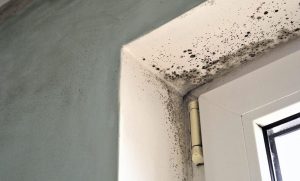
Lighting can make or break the room. One dim ceiling fixture casts shadows. Layer sconces at face height for grooming with ceiling or recessed lights for general illumination. Never skip waterproofing membranes behind tile. They protect walls and subfloors and prevent hidden leaks.
Costs and ROI in 2025: Quality ventilation fan and install 500–1,200 CAD. Lighting upgrades 600–2,000 CAD. Waterproofing membranes 800–2,000 CAD depending on area. Correcting these details preserves finishes and supports a 60–70 percent overall bathroom ROI.
13. Renovate for Value, Renovate for You
The final piece of the puzzle is perspective. The best renovations are those that make your home irresistible to buyers while also improving your own comfort and lifestyle. Kitchens, bathrooms, windows, curb appeal, and energy efficiency upgrades consistently rank among the most valuable renovations in Kingston and Frontenac. These are the projects that buyers notice immediately and are willing to pay for.
At the same time, not every improvement has to be about resale. If you plan to stay in your home for years, a personal project — whether it’s a backyard oasis, a cozy media room, or even a golf simulator — may be worth every dollar to you, regardless of the return. The real key is balance: knowing which renovations will add market value and which ones you’re doing purely for enjoyment.
Remember, renovation costs are climbing each year. The sooner you plan strategically, the further your investment will go. If you’re thinking of upgrading before selling, let’s connect. I can help you decide which renovations make the most sense for your neighbourhood and your price range.
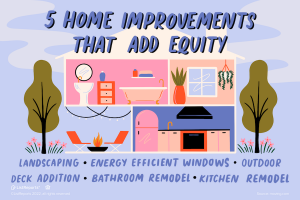
Don’t Miss These Guides
FAQ: Renovation ROI in Kingston and Frontenac
Q: Which home renovations add the most value in Kingston?
A: Kitchens, bathrooms, windows, and curb appeal consistently top the list. Energy efficiency upgrades, such as insulation and heat pumps, are also increasingly valuable in our changing climate.
Q: Should I renovate my home before selling, or price it lower?
A: Strategic renovations usually add more value than a price reduction. Even minor updates, such as fresh paint, new lighting, or refinished floors, can pay off.
Q: Are pools a good investment in this region?
A: For personal enjoyment, yes. For resale, not often. Our short summers and high maintenance costs make them less appealing to buyers.
Q: Do buyers care about energy efficiency upgrades?
A: Absolutely. With Hydro rates rising, buyers often calculate utility costs into their offers. Triple-pane windows, insulation, and smart thermostats are strong selling features.
Q: What if I want a renovation just for me, not for resale?
A: Then go for it. Copper ceilings, indoor golf simulators, or theatre rooms may not raise value, but if you’re planning to stay long-term, personal enjoyment matters more than ROI.
Q: Do security features like cameras and doorbell cams increase resale value?
A: On their own, they don’t dramatically change a home’s appraised value, but they do add appeal. Buyers increasingly see smart doorbells, motion-sensor lighting, and basic camera systems as desirable add-ons. These features create peace of mind, improve curb appeal, and may even help lower insurance premiums.



